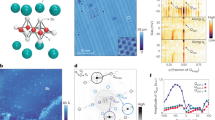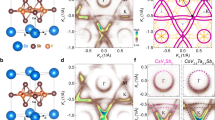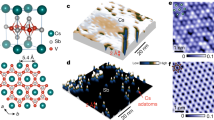Abstract
The transition metal kagome lattice materials host frustrated, correlated and topological quantum states of matter1,2,3,4,5,6,7,8,9. Recently, a new family of vanadium-based kagome metals, AV3Sb5 (A = K, Rb or Cs), with topological band structures has been discovered10,11. These layered compounds are nonmagnetic and undergo charge density wave transitions before developing superconductivity at low temperatures11,12,13,14,15,16,17,18,19. Here we report the observation of unconventional superconductivity and a pair density wave (PDW) in CsV3Sb5 using scanning tunnelling microscope/spectroscopy and Josephson scanning tunnelling spectroscopy. We find that CsV3Sb5 exhibits a V-shaped pairing gap Δ ~ 0.5 meV and is a strong-coupling superconductor (2Δ/kBTc ~ 5) that coexists with 4a0 unidirectional and 2a0 × 2a0 charge order. Remarkably, we discover a 3Q PDW accompanied by bidirectional 4a0/3 spatial modulations of the superconducting gap, coherence peak and gap depth in the tunnelling conductance. We term this novel quantum state a roton PDW associated with an underlying vortex–antivortex lattice that can account for the observed conductance modulations. Probing the electronic states in the vortex halo in an applied magnetic field, in strong field that suppresses superconductivity and in zero field above Tc, reveals that the PDW is a primary state responsible for an emergent pseudogap and intertwined electronic order. Our findings show striking analogies and distinctions to the phenomenology of high-Tc cuprate superconductors, and provide groundwork for understanding the microscopic origin of correlated electronic states and superconductivity in vanadium-based kagome metals.
This is a preview of subscription content, access via your institution
Access options
Access Nature and 54 other Nature Portfolio journals
Get Nature+, our best-value online-access subscription
$29.99 / 30 days
cancel any time
Subscribe to this journal
Receive 51 print issues and online access
$199.00 per year
only $3.90 per issue
Buy this article
- Purchase on Springer Link
- Instant access to full article PDF
Prices may be subject to local taxes which are calculated during checkout




Similar content being viewed by others
Data availability
Data measured or analysed during this study are available from the corresponding author on reasonable request.
References
Ye, L. D. et al. Massive Dirac fermions in a ferromagnetic kagome metal. Nature 555, 638–642 (2018).
Yin, J. X. et al. Giant and anisotropic many-body spin–orbit tunability in a strongly correlated kagome magnet. Nature 562, 91–95 (2018).
Liu, Z. et al. Orbital-selective Dirac fermions and extremely flat bands in frustrated kagome-lattice metal CoSn. Nat. Commun. 11, 4002 (2020).
Morali, N. et al. Fermi-arc diversity on surface terminations of the magnetic Weyl semimetal Co3Sn2S2. Science 365, 1286–1291 (2019).
Liu, D. F. et al. Magnetic Weyl semimetal phase in a Kagomé crystal. Science 365, 1282–1285 (2019).
Kuroda, K. et al. Evidence for magnetic Weyl fermions in a correlated metal. Nat. Mater. 16, 1090 (2017).
Yin, J. X. et al. Quantum-limit Chern topological magnetism in TbMn6Sn6. Nature 583, 533–536 (2020).
Yin, J.-X. et al. Negative flat band magnetism in a spin–orbit-coupled correlated kagome magnet. Nat. Phys. 15, 443–448 (2019).
Xing, Y. et al. Localized spin-orbit polaron in magnetic Weyl semimetal Co3Sn2S2. Nat. Commun. 11, 5613 (2020).
Ortiz, B. R. et al. New kagome prototype materials: discovery of KV3Sb5, RbV3Sb5, and CsV3Sb5. Phys. Rev. Mater. 3, 094407 (2019).
Ortiz, B. R. et al. CsV3Sb5: a Z2 topological kagome metal with a superconducting ground state. Phys. Rev. Lett. 125, 247002 (2020).
Yin, Q. et al. Superconductivity and normal-state properties of kagome metal RbV3Sb5 Single Crystals. Chin. Phys. Lett. 38, 037403 (2021).
Jiang, Y. X. et al. Unconventional chiral charge order in kagome superconductor KV3Sb5. Nat. Mater. 20, 1353–1357 (2021).
Zhao, H. et al. Cascade of correlated electron states in a kagome superconductor CsV3Sb5. Nature https://doi.org/10.1038/s41586-021-03946-w (2021).
Liang, Z. et al. Three-dimensional charge density wave and surface-dependent vortex-core states in a kagome superconductor CsV3Sb5. Phys. Rev. X 11, 031026 (2021).
Yang, S.-Y. et al. Giant, unconventional anomalous Hall effect in the metallic frustrated magnet candidate, KV3Sb5. Sci. Adv. 6, eabb6003 (2020).
Yu, F. H. et al. Concurrence of anomalous Hall effect and charge density wave in a superconducting topological kagome metal. Phys. Rev. B 104, L041103 (2021).
Wang, Y. et al. Proximity-induced spin-triplet superconductivity and edge supercurrent in the topological Kagome metal, K1–xV3Sb5. Preprint at https://arxiv.org/abs/2012.05898 (2020).
Zhao, C. C. et al. Nodal superconductivity and superconducting dome in the topological Kagome metal CsV3Sb5. Preprint at https://arxiv.org/abs/2102.08356 (2021).
Chen, H. et al. Evidence for ultralow-energy vibrations in large organic molecules. Nano Lett. 17, 4929–4933 (2017).
Hirjibehedin, C. F. et al. Large magnetic anisotropy of a single atomic spin embedded in a surface molecular network. Science 317, 1199–1203 (2007).
Fischer, Ø., Kugler, M., Maggio-Aprile, I., Berthod, C. & Renner, C. Scanning tunneling spectroscopy of high-temperature superconductors. Rev. Mod. Phys. 79, 353–419 (2007).
Jiao, L. et al. Chiral superconductivity in heavy-fermion metal UTe2. Nature 579, 523–527 (2020).
Lawler, M. J. et al. Intra-unit-cell electronic nematicity of the high-Tc copper-oxide pseudogap states. Nature 466, 347–351 (2010).
Fujita, K., Hamidian, M. H., Sprau, P. O., Edkins, S. D. & Davis, J. C. S. in Springer Handbook of Microscopy (eds Hawkes, P. W. & Spence, J. C. H.) 1369–1390 (Springer, 2019).
Kivelson, S. A., Fradkin, E. & Emery, V. J. Electronic liquid-crystal phases of a doped Mott insulator. Nature 393, 550–553 (1998).
Emery, V. J., Fradkin, E., Kivelson, S. A. & Lubensky, T. C. Quantum theory of the smectic metal state in stripe phases. Phys. Rev. Lett. 85, 2160 (2000).
Hamidian, M. H. et al. Detection of a Cooper-pair density wave in Bi2Sr2CaCu2O8+x. Nature 532, 343–347 (2016).
Ruan, W. et al. Visualization of the periodic modulation of Cooper pairing in a cuprate superconductor. Nat. Phys. 14, 1178–1182 (2018).
Agterberg, D. & Tsunetsugu, H. Dislocations and vortices in pair-density-wave superconductors. Nat. Phys. 4, 639–642 (2008).
Berg, E., Fradkin, E. & Kivelson, S. A. Charge-4e superconductivity from pair-density-wave order in certain high-temperature superconductors. Nat. Phys. 5, 830–833 (2009).
Lee, P. A. Amperean pairing and the pseudogap phase of cuprate superconductors. Phys. Rev. X 4, 031017 (2014).
Agterberg, D. F. et al. The physics of pair-density waves: cuprate superconductors and beyond. Annu. Rev. Condens. Matter Phys. 11, 231–270 (2020).
Liu, X., Chong, Y. X., Sharma, R. & Davis, J. C. S. Discovery of a Cooper-pair density wave state in a transition-metal dichalcogenide. Science 372, 1447–1452 (2021).
Landau, L. On the theory of superfluidity. Phys. Rev. 75, 884–885 (1949).
Feynman, R. P. in Progress in Low Temperature Physics Vol. 1 (ed. Gorter, C. J.) 17–53 (Elsevier, 1955).
Feynman, R. P. & Cohen, M. Energy spectrum of the excitations in liquid helium. Phys. Rev. 102, 1189–1204 (1956).
Nozières, P. Is the roton in superfluid 4He the ghost of a Bragg spot? J. Low Temp. Phys. 137, 45–67 (2004).
Edkins, S. D. et al. Magnetic field–induced pair density wave state in the cuprate vortex halo. Science 364, 976–980 (2019).
Dai, Z., Zhang, Y.-H., Senthil, T. & Lee, P. A. Pair-density waves, charge-density waves, and vortices in high-Tc cuprates. Phys. Rev. B 97, 174511 (2018).
Yu, S. L. & Li, J. X. Chiral superconducting phase and chiral spin-density-wave phase in a Hubbard model on the kagome lattice. Phys. Rev. B 85, 144402 (2012).
Kiesel, M. L., Platt, C. & Thomale, R. Unconventional Fermi surface instabilities in the kagome Hubbard model. Phys. Rev. Lett. 110, 126405 (2013).
Wang, W. S., Li, Z. Z., Xiang, Y. Y. & Wang, Q. H. Competing electronic orders on kagome lattices at van Hove filling. Phys. Rev. B 87, 115135 (2013).
Cho, D., Bastiaans, K. M., Chatzopoulos, D., Gu, G. D. & Allan, M. P. A strongly inhomogeneous superfluid in an iron-based superconductor. Nature 571, 541–545 (2019).
Pan, S. H., Hudson, E. W. & Davis, J. C. Vacuum tunneling of superconducting quasiparticles from atomically sharp scanning tunneling microscope tips. Appl. Phys. Lett. 73, 2992–2994 (1998).
Rodrigo, J. G., Suderow, H., Vieira, S., Bascones, E. & Guinea, F. Superconducting nanostructures fabricated with the scanning tunnelling microscope. J. Phys. Condens. Matter 16, R1151–R1182 (2004).
Naaman, O., Teizer, W. & Dynes, R. C. Fluctuation dominated Josephson tunneling with a scanning tunneling microscope. Phys. Rev. Lett. 87, 097004 (2001).
Kimura, H., Barber, R. P., Ono, S., Ando, Y. & Dynes, R. C. Josephson scanning tunneling microscopy: a local and direct probe of the superconducting order parameter. Phys. Rev. B 80, 144506 (2009).
Šmakov, J., Martin, I. & Balatsky, A. V. Josephson scanning tunneling microscopy. Phys. Rev. B 64, 212506 (2001).
Proslier, T. et al. Probing the superconducting condensate on a nanometer scale. Europhys. Lett. 73, 962–968 (2006).
Kresse, G. & Furthmuller, J. Efficiency of ab-initio total energy calculations for metals and semiconductors using a plane-wave basis set. Comput. Mater. Sci. 6, 15–50 (1996).
Kresse, G. & Furthmuller, J. Efficient iterative schemes for ab initio total-energy calculations using a plane-wave basis set. Phys. Rev. B 54, 11169–11186 (1996).
Perdew, J. P., Burke, K. & Ernzerhof, M. Generalized gradient approximation made simple. Phys. Rev. Lett. 77, 3865–3868 (1996).
Grimme, S., Antony, J., Ehrlich, S. & Krieg, H. A consistent and accurate ab initio parametrization of density functional dispersion correction (DFT-D) for the 94 elements H-Pu. J. Chem. Phys. 132, 154104 (2010).
Togo, A. & Tanaka, I. First principles phonon calculations in materials science. Scr. Mater. 108, 1–5 (2015).
Agterberg, D. F., Melchert, D. S. & Kashyap, M. K. Emergent loop current order from pair density wave superconductivity. Phys. Rev. B 91, 054502 (2015).
Tan, H., Liu, Y., Wang, Z. & Yan, B. Charge density waves and electronic properties of superconducting kagome metals. Phys. Rev. Lett. 127, 046401 (2021).
Ortiz, B. R. et al. Fermi surface mapping and the nature of charge density wave order in the kagome superconductor CsV3Sb5. Preprint at https://arxiv.org/abs/2104.07230 (2021).
Li, H. X. et al. Observation of unconventional charge density wave without acoustic phonon anomaly in kagome superconductors AV3Sb5 (A=Rb,Cs). Phys. Rev. X 11, 031050 (2021)
Acknowledgements
We thank I. Zeljkovic, S. Wilson, J. Yin and Z.-X. Zhao for helpful discussions. The work is supported by grants from the National Natural Science Foundation of China (61888102, 52022105, 11974422, 51771224 and 11974394), the National Key Research and Development Projects of China (2016YFA0202300, 2017YFA0206303, 2018YFA0305800 and 2019YFA0308500) and the Chinese Academy of Sciences (XDB28000000, XDB30000000, XDB33030100 and 112111KYSB20160061). Z.W. is supported by the US DOE, Basic Energy Sciences grant no. DE-FG02-99ER45747.
Author information
Authors and Affiliations
Contributions
H.-J.G. designed the experiments. H.C., B.H., Y.X., G.Q., Z.H., Y.Y., C.S. and G.L. performed STM experiments with guidance from H.-J.G. and H.Y. Z.Z. and H.L.prepared samples. Q.Y., C.G. and Z.T. also participated in sample preparation. X.D., J.Y., H.Y., S.M., H.Z. and S.N. performed the transport experiments. Z.W., S.Z., H.T. and B.Y. carried out theoretical work. All of the authors participated in analysing experimental data, plotting figures and writing the manuscript. H.-J.G. and Z.W. supervised the project.
Corresponding authors
Ethics declarations
Competing interests
The authors declare no competing interests.
Additional information
Peer review information Nature thanks the anonymous reviewers for their contribution to the peer review of this work.
Publisher’s note Springer Nature remains neutral with regard to jurisdictional claims in published maps and institutional affiliations.
Extended data figures and tables
Extended Data Fig. 1 Detailed STM characterization of the Sb and Cs surfaces.
a, Top panel: a typical STM image showing a step edge of Cs surface. Bottom panel: line profile along the white dotted arrow in a, indicating that the height of the step edge is ~0.95 nm, which is consistent with the calculated interlayer distance (Vs = -1 V, It = 0.1 nA). b, Atomically-resolved STM image of Cs surface, showing a hexagonal lattice with a period of 1.0 nm, which is \(\surd 3\) times larger than the lattice constant (\(a=b=\,\)0.55 nm, see Fig. S1a). (Vs = -500 mV, It = 0.5 nA). c, Atomically-resolved STM image of Sb surface, showing a honeycomb lattice. The periodicity of the honeycomb lattice is about 0.56 nm, which agrees with the bulk lattice constant (\(a=b=\,\)0.55 nm, see Fig. S1a). (Vs = -500 mV, It = 0.5 nA). d, Atomically-resolved STM image of an interface between the top Cs and bottom Sb surfaces (same as in Fig. 1d). The atomic model is overlaid on the image, showing that each Cs atom sits on top of the Sb honeycomb center (Vs = -500 mV, It = 0.5 nA). e, FFT of d showing the Cs √3 × √3R30o reconstruction relative to the Sb 1 × 1 lattice. f, g Top panels: schematics showing STM manipulations to expose the bottom Sb surface. Bottom panels: STM images of Cs surface before (f) and after (g) STM manipulation, respectively, showing the freshly-obtained bottom Sb surface highlighted by the white dotted square (Vs = -500 mV, It = 0.5 nA).
Extended Data Fig. 2 STM topography and dI/dV maps over a 40 nm × 40 nm region at 300 mK.
a, Topography, dI/dV maps and the intensity of the drift-corrected Fourier transforms at the sample bias from -2 mV to 0 mV, respectively. Each map consists of 500 pixels × 500 pixels. b, Energy dependence of the Fourier line cuts along the three directions of the hexagonal zone. (Vs = -5 mV, It = 2 nA, Vmod = 0.5 mV).
Extended Data Fig. 3 Absence of 4a0/3 in high energy dI/dV maps at 300 mK.
a, Large-scale STM image (60 nm × 60 nm) of the Sb surface obtained at the temperature below Tc (300 mK), where a unidirectional charge order is visible (Vs = -20 mV, It = 2 nA). b, The magnitude of drift-corrected Fourier transform of a, showing clearly the Q3q-2a CDW and Q1q-4a stripe CDW peaks. c, d dI/dV mapping (1024 pixels × 1024 pixels) over the same region at -20 mV and the corresponding magnitude of drift-corrected Fourier transform (Vs = -20 mV, It = 2 nA, Vmod = 0.2 mV). d, f dI/dV mapping (1024 pixels × 1024 pixels) over the same region at -30 mV and the corresponding magnitude of drift-corrected Fourier transform (Vs = -30 mV, It = 2 nA, Vmod = 0.2 mV).
Extended Data Fig. 4 Schematic illustration of the roton-PDW.
Top panel: the roton dispersion and roton minimum at Qroton = Q3q-4a/3 in the reciprocal lattice. Bottom panel: the 3Q roton-PDW at Qpdw = Qroton forming a commensurate vortex-antivortex lattice (red, blue and yellow circles) that spatially modulates the tunneling conductance spectra along a line cut.
Extended Data Fig. 5 Spatial map of pseudogap and Q3q-4a/3 modulations.
a, Spatially-averaged dI/dV spectrum obtained below Tc, exhibiting several peaks in the energy range between 1 mV and 6 mV (Vs = -10 mV, It = 1 nA, Vmod = 0.05 mV). The PDW pseudogap peak located near 5 mV is labelled as P. b, Waterfall and color plot of a dI/dV line cut, showing spatial modulations of the peak P (Vs = -3.7 mV, It = 1 nA, Vmod = 0.05 mV). c, Spatial gap map of ∆*(r), showing the spatial modulations of the pseudogap (Vs = -3.7 mV, It = 1 nA, Vmod = 0.05 mV). d, Fourier transform of the pseudogap map showing peaks at the PDW vectors Q3q-4a/3 circled in magenta.
Extended Data Fig. 6 Charge ordered normal state in CsV3Sb5 above Tc.
a,b Large-scale STM topography of Sb surface obtained at 4.2 K and the magnitude of drift-corrected Fourier transform, showing 2a0 × 2a0 and 4a0 striped CDW peaks at wave vectors Q3q-2a and Q1q-4a (Vs = -90 mV, It = 2 nA). c,d dI/dV mapping of a at 20 mV and the magnitude of drift-corrected Fourier transform, respectively (Vs = -90 mV, It = 2 nA, Vmod = 0.5 mV). e. Energy dependence of the Fourier line cuts along qa directions, showing that peaks at Q3q-2a and Q1q-4a at 4 K are non-dispersive (Vs = -90 mV, It = 2 nA, Vmod = 0.5 mV).
Extended Data Fig. 7 Normal state angular-dependent magnetoresistance.
a, Schematic of the in-plane resistance measurement under a 5 T magnetic field by rotating the sample along c axis of the single crystal. b, Angular plot of the normalized anisotropic magnetoresistance \((\varDelta R/\,{R}_{min},\varDelta R=R(\theta )-{R}_{min})\), showing two-fold symmetry at the temperature below ~50 K. \(\theta \) is defined in a. c, Temperature dependence of the angular-dependent of at \(\varDelta R/\,{R}_{min}\) the angle of 28°, showing the onset of two-fold rotational symmetry below T*∼ 50 ± 10 K.
Supplementary information
Supplementary Information
Supplementary Figs. 1–16.
Rights and permissions
About this article
Cite this article
Chen, H., Yang, H., Hu, B. et al. Roton pair density wave in a strong-coupling kagome superconductor. Nature 599, 222–228 (2021). https://doi.org/10.1038/s41586-021-03983-5
Received:
Accepted:
Published:
Issue Date:
DOI: https://doi.org/10.1038/s41586-021-03983-5
This article is cited by
-
Nature of charge density wave in kagome metal ScV6Sn6
npj Quantum Materials (2024)
-
Violation of emergent rotational symmetry in the hexagonal Kagome superconductor CsV3Sb5
Nature Communications (2024)
-
Correlated order at the tipping point in the kagome metal CsV3Sb5
Nature Physics (2024)
-
Competing itinerant and local spin interactions in kagome metal FeGe
Nature Communications (2024)
-
Two-fold symmetric superconductivity in the Kagome superconductor RbV3Sb5
Communications Physics (2024)
Comments
By submitting a comment you agree to abide by our Terms and Community Guidelines. If you find something abusive or that does not comply with our terms or guidelines please flag it as inappropriate.



